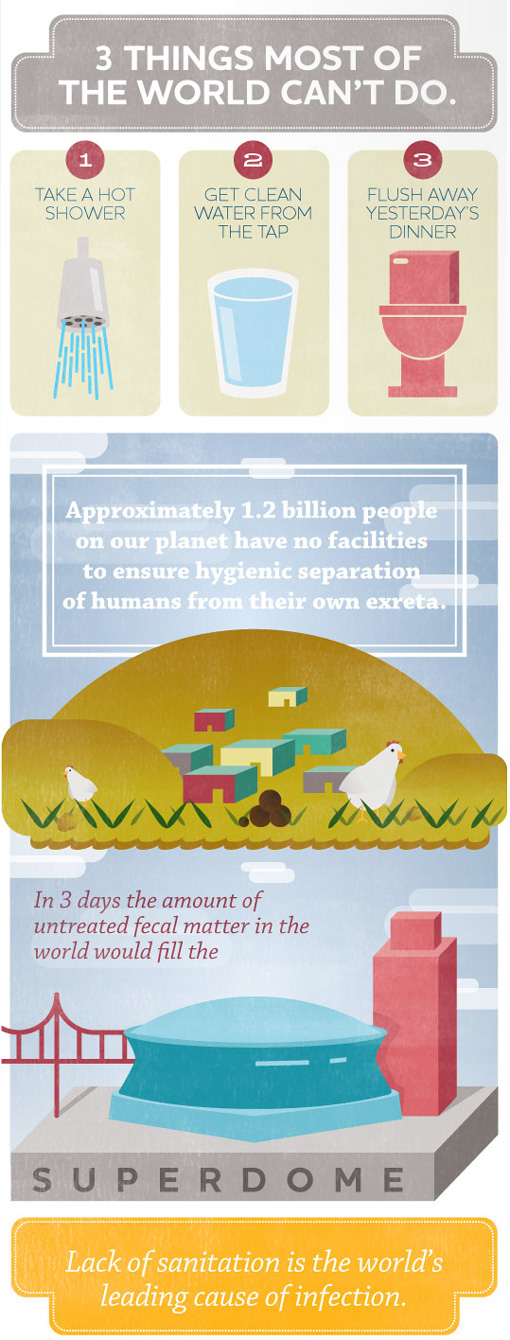Inadequate sanitation and water-related illness are two of the main causes of death and sickness in the world today. They go hand in hand. If someone doesn’t have the opportunity to dispose of their excrement properly, then that in turn, could lead to the contamination of their fresh water source, or to the soil in which they plant their crops or where their children play. These instances may not impact us or affect us greatly here in the United States, and that may be the reason why these issues are either being ignored or not known. Using a toilet, washing your hands in a sink, or even going to the faucet for a fresh, clean drink of water are luxuries to many, many people in the world, and we as a whole, take them for granted. To put this into perspective, here are some statistics and facts from water.org:
- Every 20 seconds, a child dies from a water-related illness
- Diarrhea is the second leading cause of death among children under the age of 5 in the world. Approximately 1.5 million deaths per year. This kills more children than malaria, AIDS, and measles combined
- Nearly 1 billion people lack access to safe water
- 443 million school days are lost each year due to water-related illnesses.
- Half of the hospital beds in the world are occupied by patients suffering from diseases associated with lack of access to safe drinking water, inadequate sanitation and poor hygiene
- Only 63% of the world’s population has access to improved sanitation- defined as a sanitation facility that ensures hygienic separation of human excreta from human contact
- 88% of global cases of diarrhea is estimated to be attributed to unsafe drinking water, inadequate sanitation, and poor hygiene
Instead of just referring to an illness as a water-related illness, I think it’s necessary to list some of these diseases by name and briefly describe each one. The first disease, and arguably the most familiar one is diarrhea. This is caused by several different micro-organisms, which include bacteria, viruses and protozoans. Diarrhea is described as loose stool at least three times a day. When someone suffers from this, they can become severely dehydrated, which can lead to death. “Diarrhea is the most important public health problem directly related to water and sanitation. Next to providing adequate sanitation facilities, it is the key to preventing water-borne diseases.”(2) A second disease that is associated with contaminated water is cholera. “Cholera is an acute bacterial infection of the intestinal tract. It causes severe attacks of diarrhea that, without treatment, can quickly lead to acute dehydration and death.”(2) Intestinal worms, also known as helminthes, are another disease that plagues humans in unsanitary conditions. These worms include the roundworm, the whipworm Trichuris trichiura, and the hookworms Necator americanus and Anclystoma duodenale. Although these worms are not necessarily fatal, they do hinder cognitive development. With the inability to think and reason effectively, these worms can cause a vicious cycle when people aren’t able to progress and evolve. These are just a few of the many diseases that wreak havoc on the less fortunate. Here are some facts regarding diseases in water and inadequate sanitation from water.org:
- 1/10 of the global disease burden could be prevented by improving water supply sanitation
- Improved sanitation facilities are estimated to result in an average reduction in cases of diarrhea of more than 33%
- Every 21 seconds, a child dies from diarrhea. This amounts to approximately 4100 children per day
- Women spend 200 million hours per day collecting water
- The majority of illness is caused by fecal matter
- More people have a cell phone than a toilet
- Only 10% of waste water gets treated, the rest goes into our lakes, rivers and oceans
- Approximately 1.2 billion people on our planet have no facilities to ensure hygienic separation of humans from their own excreta.
Online Sources
(1)http://www.who.int/water_sanitation_health/hygiene
(2)http://www.unicef.org/wash/index_wes_related.html
(3)http://www.water.org/water-crisis/water-facts/sanitation/

No comments:
Post a Comment